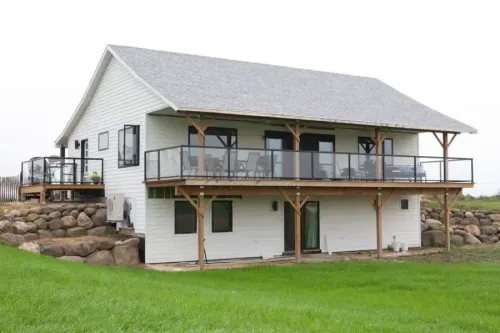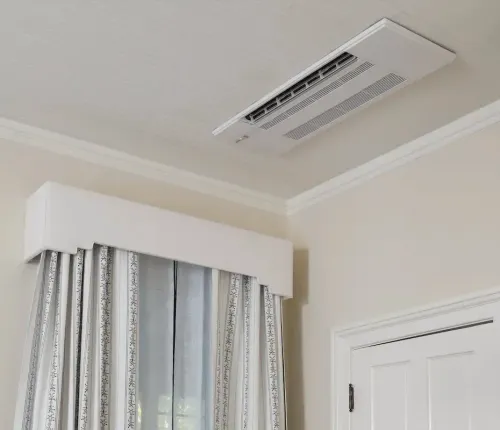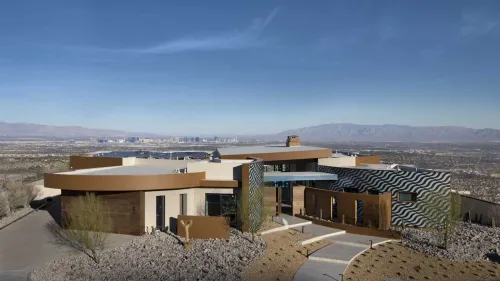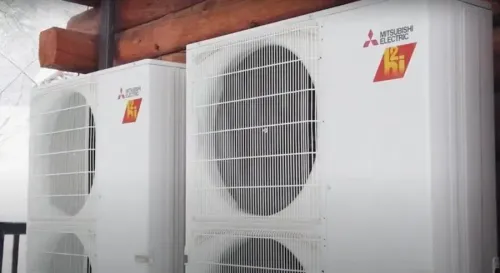Project Location: Hollis, New Hampshire
Completion Date: August 2018
Challenge
School built in 1952 required a retrofit to increase sustainability and comfortSolution
Mitsubishi Electric Zoned Comfort Solutions®Result
A sustainable and comfortable learning environment for students
Hollis Primary School (HPS) in Hollis, New Hampshire has served its community for generations. Just as the school’s dedicated teachers continually refresh the curriculum for students in pre-kindergarten through third grade, the community, led by the school staff, school board, parents and the Hollis Energy Committee, recognized the need to modernize the building for comfort and sustainability. Mitsubishi Electric would prove essential to this retrofit.
HPS is housed within a brick masonry building built in 1952. Prior to its modernization, the facility had no insulation. The walls had an R-value of 1, equivalent to a single pane of glass. The uninsulated slab of the building was above grade and resulted in cold floors during low ambient outdoor temperatures.. The heat provided by the oil boilers provided minimal comfort. Additionally, on the south and east sides of the building, windows made up about 65% of the exterior envelope. This reflected 1950s-era design and was intended to maximize natural light but resulted in excess solar gain and heated masonry, which produced uncomfortable temperatures as high as 92 degrees well into November and December. These conditions challenged educators and their students.
“It was awful,” commented Paula Izbicki, principal, HPS. “No matter what the temperature was outside, we would have really hot classrooms and really cold classrooms. If you walked through a hallway from one classroom to another, you could experience a 10-degree difference in temperature. Some kids were sweating and wearing shorts all winter long, while other kids would have their jackets on because they were cold. The situation wasn’t conducive to learning.”
The Hollis school board formed the Hollis Schools Thermal Electrical Project (HSTEP) to identify the best way to improve comfort at the school while also increasing sustainability. “We have a lot of engineers in our town and a vocal, active community that values education,” said Izbicki. “All ideas and proposals were thoroughly vetted and questioned.”
Working with HSTEP, the Hollis Energy Committee recruited Dick Henry, founding director of DDH Energy Consulting, LLC based in Concord, New Hampshire, to draw upon his expertise in helping building owners, utility companies and communities maximize energy efficiency and retrofit aging infrastructure. Henry ultimately recommended encasing the brick structure in a spray-foam envelope and installing heat pumps from Mitsubishi Electric for energy-efficient heating and air conditioning powered by electricity from solar panels.
Insulation And Load Management
To maximize comfort and enable optimal performance of the air-source heat pumps, Henry advised HPS to fully insulate the building, including the above grade slab. This included adding triple-glazed windows and applying 4 inches of spray foam for insulation.
“If we’re going to use air-source heat pumps, the first thing we have to do is get the load down as low as possible,” said Henry. “In the winter, with no insulation and an above-grade slab, the old heating system was fighting the building’s thermal mass. We applied 4 inches of foam to the exterior and took the building from an R-value of 1 to an R-value of 31. We also reduced the amount of fenestration. Now the mass can work for the school rather than against it.”
While conventional systems have fixed-speed compressors and always use the capacity required to heat or cool during design-temperature extremes, the Mitsubishi Electric heat pumps installed at HPS have variable-speed compressors that adjust the system’s capacity to match a zone’s actual load. In most cases, this will be a partial load, rather than the full load of a design temperature. “You want to set the temperature and leave it alone. It’s not like the oil boilers the school had. When you have air-source heat pumps, you get the most efficiency at part load.” noted Henry.
Comfort And Carbon Footprints
The heat pumps from Mitsubishi Electric provide both heating and air conditioning to improve the educational environment at HPS. Each zone, including each of the retrofitted 900-square-foot classrooms, is served by a Wall-Mounted Indoor Unit. Equipped with Hyper-Heating INVERTER (H2i®) technology for heating during severe cold, the school’s MXZ multi-zone outdoor units use only the precise amount of energy needed to keep each zone at its set-point. This ability to modulate compressor performance means less electrical consumption, making the system a natural fit for how the school uses renewable energy.
Since they’re occupied primarily during the day, schools are often well-suited for solar arrays. Many have flat roofs and are only one to two stories high. Using solar panels with heat pumps enabled HPS to reduce reliance on fossil fuels and increase sustainability along with comfort.
“The HVAC load factor for a school lines up very nicely with the delivery and generation pattern of a solar installation and gives real economic benefits with air-source heat pumps,” said Henry. “If you use solar power behind the meter to power heat pumps, not only are you getting the full value of offsetting the 16.5 to 20 cents kilowatt charge you’re paying from the grid, you are dramatically reducing your oil consumption. Also, the cost of electricity, by and large, is less volatile than the cost of fossil fuels. If you’re a school trying to budget for the next five to ten years, you’ll have a better idea of your likely costs. And if you have any concerns about your carbon footprint, you check off that box as well.”
The increased sustainability enabled by the retrofit also serves an educational function. HPS includes environmental science in its curriculum and expanded its program to include tools like an online dashboard where students can access information about the school’s solar energy use. Izbicki said, “Part of what we’re doing is helping our kids figure out how they can use and interpret real time data about spikes and valleys to figure out how to be more environmentally friendly with energy consumption.”
First-Class Comfort
In terms of comfort, the retrofit transformed HPS. “The experience has been great,” commented Izbicki. “When you set the units to a certain temperature, the room just stays at that temperature. So, we’re comfortable and we don’t really think about the system. The kids are energetic and much happier. The learning environment has improved dramatically because it is so much more comfortable.”
In addition to thermal comfort, the insulation and heat pumps also improved the learning environment when it comes to noise levels. “Several teachers and staff on the first day back noticed how wrapping the building had almost soundproofed it,” said Izbicki. “There is less outside noise to distract us. You no longer hear the trucks roaring past the school. And you can’t really hear the new units either, unless you paid special attention as one was getting ready to blow air.”
In this case, modernization meant continuity for the community. Rather than spending an estimated 17 million dollars on a new school building, the town of Hollis successfully retrofitted the older facility to better serve the community and its students well into the future. Dana Fischer, area manager, Mitsubishi Electric Trane HVAC US, said, “What’s exciting for me on this project is that it highlights how communities can dramatically reduce carbon footprints and energy consumption by incorporating Mitsubishi Electric heat pumps when retrofitting buildings such as schools.”
Project Team
- Architect: Windy Hill Associates, New Boston, New Hampshire
- Mechanical Engineer: John F. Penney Consulting Services, P.C., Chester, Vermont
- Energy Consultant: Ddh Energy Consulting, Llc, Concord, New Hampshire
Mitsubishi Electric Equipment Installed
- (13) MXZ M-Series Hyper-Heating INVERTER® H2i® Multi-Zone Outdoor Heat Pumps
- (33) MSZ Wall-Mounted Indoor Units









